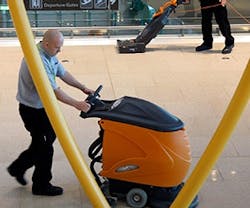The Truth About Slip and Fall Hazards
Same-level slip-and-fall accidents are the leading cause of workplace injuries, totaling nearly 200,000 in 2015. The 2017 Liberty Mutual Workplace Safety Index reports that these types of falls resulted in almost $11 billion in workers’ compensation and medical costs last year.
New Pig, an authority on leaks, drips and spills, released the Walk Zone Safety Report, an in-depth look at slips, trips and falls in workplaces and public facilities.
New Pig surveyed professionals in maintenance, safety, health risk and facilities management across multiple industries and found that many organizations underestimate floor safety risks and are unaware of high-risk walk zones that exist within their buildings, exposing them to significant liability, medical costs, productivity losses and damage to brand reputation.
Related: 4 Tips for Carpet Replacement
To obtain a better understanding of why this problem persists — despite well-documented risks and the new OSHA standard on walking-working surfaces — New Pig shepherded a survey of floor safety professionals at manufacturing and public-facing facilities, such as supermarkets, stores and other commercial spaces. [Note: All fall-related survey questions focused only on same-level falls, excluding falls from heights.]
Conclusions drawn from the survey include the following points:
- Much more needs to be done to prevent falls: In 2016, businesses paid $11 billion in direct costs for slips, trips and falls. Even though the overwhelming majority (92 percent) of companies place floor mats in their entranceways, often leave numerous other risk zones uncovered.
- More emphasis needs to be placed on educational efforts: A majority of respondents (54 percent) were also not aware of the final OSHA Walking-Working Surfaces rule, which took effect in January of 2017.
- Eliminate moisture and increase traction in existing risk zones: Ensure there is adequate walk-off at all entrances (at least ten feet worth of floor mat) to adequately capture tracked-in dirt and moisture.
“This survey was a real eye-opener for us,” says Dan Silver, New Pig’s vice president of product development.
“We learned from some really dedicated people that protecting employees or customers requires a change of mindset from a narrow location-specific view to a more holistic entire-facility view of floor safety. Terms like “walkway audit” and “safety planogram” need to become part of their regular vocabulary. Great solutions are out there to dramatically reduce slip and fall risks.”
The survey results indicate that 51 percent of organizations identified the entranceway as the location of most slips, trips and falls in their building. The likely cause of many of these was rain and snow, which was identified as the primary cause of falls by 37 percent of respondents.
However, less than half of respondents address other fall zones — beyond entranceways — with floor mats, leaving these areas completely unprotected. These include the areas around equipment or machines (covered by a floor mat by 35 percent of respondents), employee walkways and aisles (24 percent), transition areas (20 percent) and kitchens (9 percent).
Two handpicked articles to read next:
